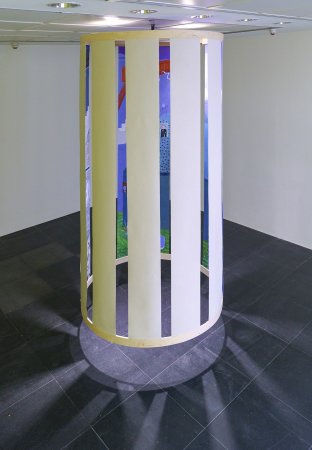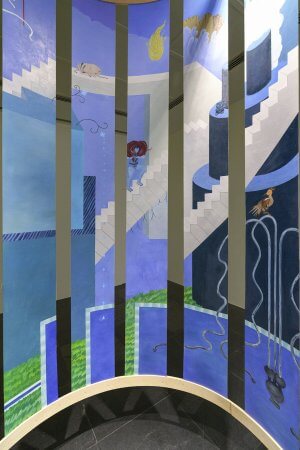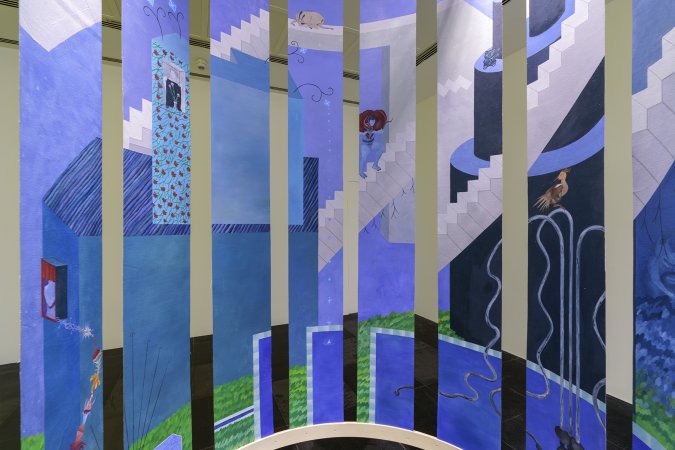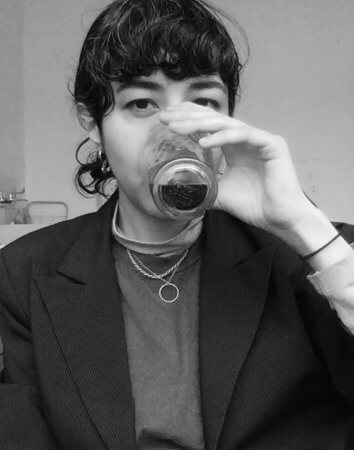Anita Esfandiari
Gave to the cypress a rosy shade of the redbud; and to the tulip gave the stature of a bambuseae, 2023
Mixed media
⌀ 150 x 300 cm
Courtesy the artist
Trained as a painter in Tehran, Iran, Anita Esfandiari worked with sculpture, drawing and installation during her studies at the Städelschule. The formal starting point of her entire artistic production is always the fountain, whether as a drawing, ceramic or fabric sculpture, or as an installation with sound. Fountains are typical elements of architecture in Iran. Part of private and public spaces, they serve as places to relax and meet at in large cities. They stand for abundance in a region marked by drought. Formerly of great importance, fountains have now become a symbol of abandonment. They have not been built for years, but can still be found in traditional houses. In public spaces, they are losing their function as meeting places and are being converted into underground stations or monuments.
In her new work for the Frankfurter Kunstverein, Anita Esfandiari uses artistic symbolism creating a kinetic sculptural painting whose form is derived from that of a fountain. 12 canvas panels 3 m high hang circularly from the ceiling, forming a slightly open cylinder that rotates. The visitors can glimpse passing sections through the slits. The cylinder recalls the praxinoscope of early cinema, which tells a story in many individual images through their circular movement. Like water in a fountain, the images flow, with each fabric panel representing an hour of the day. The images can be read on two interconnected levels, as quotations from Persian literature and miniature painting, as well as the singular, symbolic media images that are in constant circulation but do not nearly approximate a complete picture of the present time and political situation in Iran.
Anita Esfandiari creates a pictorial panorama that interweaves symbolic elements from the classical epic and the present. In the foreground, ornamental fountains, geometric buildings and streets can be seen. A woman, the protagonist, carries a lamb on her shoulders. Again and again, she runs up an endless flight of stairs. This is a tale from the Persian epic Haft Peykar, a famous literary reference in Iran, about the life of King Bahram Gur and his seven princesses. The story begins with the fate of Feṭna, Bahram Gur’s mistress, who is sentenced to death for challenging the arrogant and self-proclaimed brilliant hunter King Bahram Gur. Thanks to her cleverness, she survives the death sentence and dedicates her life to taking revenge on the king. She thus becomes a female symbol of resilience.
Anita Esfandiari (*1985 in Tehran, IR) graduated in 2022 from the Hochschule für Bildende Künste – Städelschule in Frankfurt am Main (DE) with Prof. Judith Hopf. Previously, she studied painting, art and architecture at the Islamic Azad University in Tehran (IR). She mainly works with sculpture, painting and video. In 2022 she spent a period abroad in Hendaye (FR). Institutions Anita Esfandiari has exhibited her work at include: Medium P, Frankfurt am Main (DE), Opelvillen, Rüsselsheim (DE), Abi Gallery, Tehran (IR), Delgosha Art Gallery, Tehran (IR), Columbus Museum of Art, Ohio (US).





